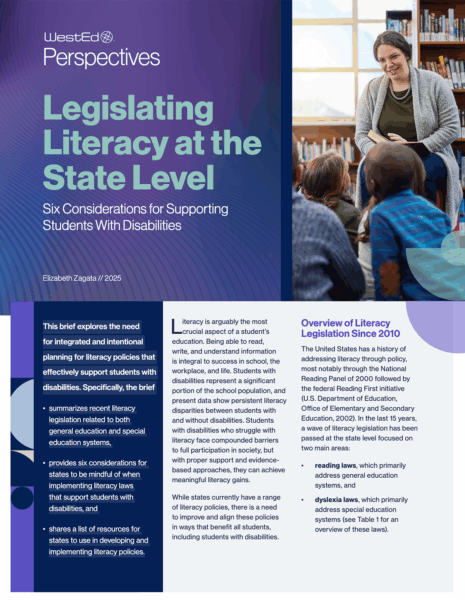
July 22, 2025
By Matt Brunetti
Across the country, states are strengthening their efforts to help young children learn to read. Over the past decade, 40 states have passed legislation or implemented policies aimed at strengthening evidence-based reading instruction. More than 30 states now require early literacy assessments to help schools evaluate students for risk of reading difficulties, including dyslexia. But as promising as this sounds, are these assessments being used in ways that truly help students?
My colleagues, Meredith Langi and Sarah Quesen, and I recently explored how early literacy assessments are being used across the United States. In our paper titled Are We on the Same Page? A Discussion on the Use and Misuse of Early Literacy Assessments, presented at the National Council of Measurement in Education (NCME) Annual Meeting in April 2025, we analyzed and shared insights on policies from seven states: Arkansas, California, Colorado, Kentucky, Maryland, Massachusetts, and Mississippi. Our findings revealed both progress and potential shortcomings in the current landscape of early reading policies and practices.
“Ensuring that assessments are used for their validated purposes is essential to supporting effective literacy development.”
The Promise of Early Literacy Assessments
Early literacy assessments play a critical role in helping educators identify students who might need extra support in mastering the foundational skills of reading—skills like sounding out words, recognizing letters, and building fluency. Many of these assessments are often referred to as screeners, which are brief tools that help teachers identify students who may need extra support with foundational reading skills and determine whether further diagnostic assessment is needed.
The push for better reading instruction is grounded in evidence-based reading practices, often referred to as the science of reading, which emphasize that becoming a skilled reader requires both decoding skills and language comprehension. Further, learning to read by 3rd grade is often seen as an important milestone in a child’s academic journey, influencing their success for years to come.
But as many states have embraced these assessments, our analysis shows variation in how they are used, leading to potential misalignment with the design and intended use of these assessments or with the desired outcomes of legislation and policy.
An Assortment of Policies
In analyzing the policies of the seven states in our analysis, we found significant differences in their approaches and use of early literacy assessments. Some states use early literacy assessments simply as an early warning system to flag students who might need additional instructional support (i.e., screening). Others use them to define reading difficulties more formally or even to make promotion decisions.
California’s approach encourages using assessments as an initial flag to prompt further evaluation and support. Similarly, Kentucky, Maryland, Massachusetts, and Mississippi require the administration of universal reading screeners at least once annually. Each of these states provides an approved list of screening instruments that meet the legislative requirements and encourage more in-depth evaluation for students who are identified via the screening process as having potential reading challenges.
Arkansas and Colorado use a more comprehensive approach. Arkansas’s statewide K–3 ATLAS assessment system combines early literacy and dyslexia screening with interim and summative tools to identify reading deficiencies and provide teachers with actionable data for targeted instruction. Colorado follows a similar model that differentiates between interim, diagnostic, and summative assessments, helping educators understand not just who needs help but also what kind of help they need. Whereas Arkansas utilizes a single assessment system, Colorado provides a list of approved assessments for districts to choose from.
“When legislation clearly distinguishes between screening, diagnostic, and progress monitoring purposes, educators are better positioned to use assessment results appropriately.”
The Problem of Misalignment
Despite the good intentions behind these laws, we found some evidence of potential misalignment between policy and practice. Perhaps most concerning is the inconsistency of results across various tools. As previously mentioned, states often approve multiple early literacy assessments, each with its own scoring model and definition of “risk.” As a result, two students with nearly identical reading skills could be classified differently depending solely on which assessment their district or school uses. Further, many states do not clearly define what it means for a student to be “at risk” for reading difficulties, leading to possible misinterpretation of assessment results.
Our analysis also showed that many literacy assessments focus heavily on foundational reading skills, like phonics and decoding, but give less attention to comprehension skills, like vocabulary, background knowledge, and verbal reasoning, which are essential for long-term reading success.
Finally, most of the available assessments were originally designed as tools to guide instruction and catch reading problems early. However, in some states, they are now being used for high-stakes decisions, including whether students are promoted to the next grade. This shift raises serious concerns about fairness and accuracy, especially when assessments were not built or validated for such uses.
“Misalignment between assessment design and legislative implementation introduces additional risks.”
Potential Missed Opportunities
Many assessments were developed primarily for English-speaking students and do not fully account for the needs of Multilingual Learners or students with disabilities. Without clear accommodations or guidance, educators risk misclassifying students or overlooking their unique instructional needs. For a more in-depth exploration on this topic, I recommend the paper Legislating Literacy at the State Level: Six Considerations for Supporting Students With Disabilities by my colleague Elizabeth Zagata, which discusses the importance of inclusive literacy policies and offers strategies for effectively meeting the diverse needs of multilingual learners and students with disabilities.
Adding to the challenge is the fact that educators often lack the training or support needed to interpret assessment results appropriately. As a result, the potential of early literacy screening often gets lost due to incomplete follow-up instruction and a lack of adequate resources.
“Screening alone is insufficient; it must be combined with diagnostic evaluation, timely intervention, and ongoing instructional support.”
Getting on the Same Page
If we want every child to have a fair shot at reading success, we need systems that reflect the complexity of literacy development and give teachers the tools they need to help every student grow. This starts with policymakers, state leaders, educators, and assessment developers working together to make sure early literacy assessments are aligned with their intended purposes. Early literacy assessments work best when part of a comprehensive and coherent system of literacy instruction and intervention.
We encourage better use of early literacy assessments by
- defining clearly the role of each type of assessment (screening, diagnostic, progress monitoring) and how the results can (and cannot) be used;
- aligning assessment goals with the broader vision of literacy development, including clearly defining what it means to be at risk for reading difficulties;
- requiring follow-up diagnostic evaluations and evidence-based interventions after screening for students who might be at risk for reading difficulties;
- providing stronger supports for students with disabilities and Multilingual Learners, including offering assessments in languages other than English; and
- ensuring that teachers receive ongoing training to interpret results accurately and act on them effectively.
Early literacy assessments should be seen as instructional tools, not as roadblocks. They can only be effective when combined with evidence-based instruction, ongoing professional development, and coordinated resources for students and families. Getting on the same page means committing to providing all students with meaningful opportunities to succeed.
Matt Brunetti is a senior program associate with the Assessment Research and Innovation team and specializes in early childhood assessments, psychometric analysis, and assessment design.
Early Childhood Assessment Services
Our Early Childhood Assessment Services draw on our deep and comprehensive expertise in early learning and development along with standards and assessment to provide highly customizable services. We collaborate with each client to understand specific contexts and needs; then, we use our holistic approach to customize resources and services that support your work.
Learn more about Early Childhood Assessment Services at WestEd.










